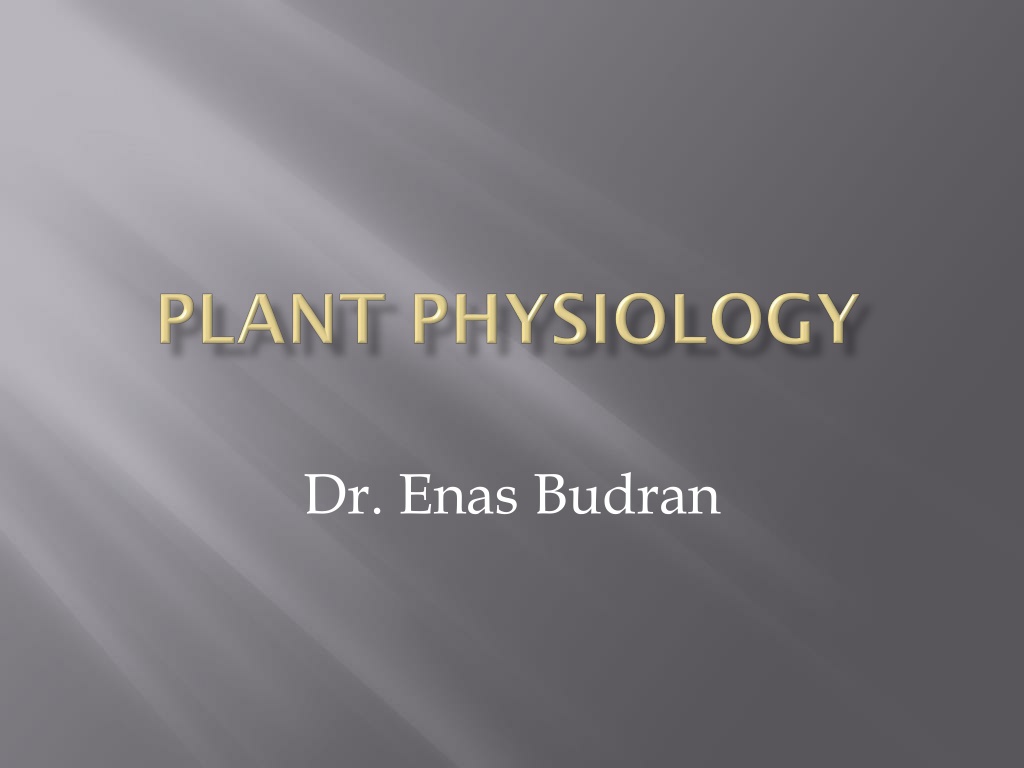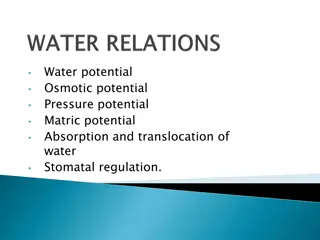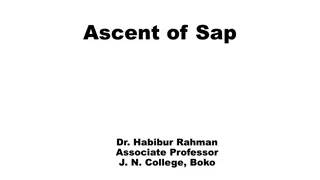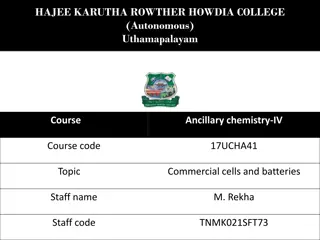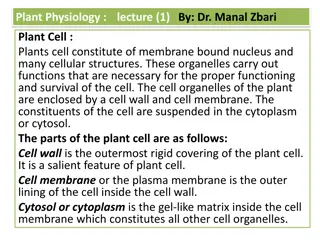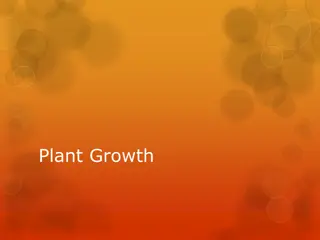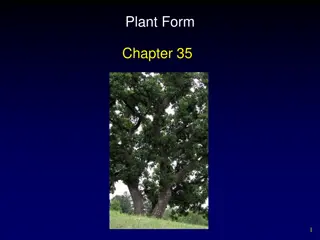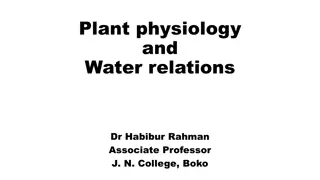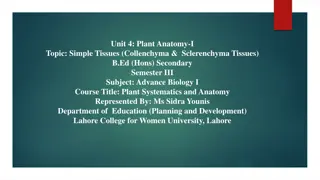Understanding Osmotic Systems in Plant Cells
Plant cells function as osmotic systems where factors like solvent purity, solute concentration, and cell turgidity affect water movement. Osmotic pressure varies with factors like cell age, position, and plant habitat. Permeability of membranes, passage of substances, and laws of diffusion are crucial in understanding osmotic processes in plant biology.
Download Presentation

Please find below an Image/Link to download the presentation.
The content on the website is provided AS IS for your information and personal use only. It may not be sold, licensed, or shared on other websites without obtaining consent from the author. Download presentation by click this link. If you encounter any issues during the download, it is possible that the publisher has removed the file from their server.
E N D
Presentation Transcript
Plant cells as osmotic systems OP TP WP TP=WP DPD (SF)
In pure solvent SF is related with OP and TP SF = OP TP For fully turgid cells SF = 0 OP = TP For fully plasmolyzed cells the value of TP = 0 SF = OP In a hypotonic solution (OP1) SF = (OP OP1) TP Sf= OP (TP+OP1) Entry of water depends on SF OP=3 TP=2 SF=1 OP=4 TP=2 SF=2 OP=3 TP=1 SF=2 OP=4 TP=3 SF=1
Factors affecting osmotic pressure 1- The habitat of the growing plant OP changes according to the surrounding medium. Salt increases OP of the growing plants due to absorption and accumulation of salts decomposition of the organic substances. hydrophytes mesophytes xerophytes halophytes
2- Plant type OP differs from plants to another. trees shrubs herbs annuals perennial
3- Age of plant cell or tissue The OP in old plants In the young leaves growing regions 4- Position of cells or tissues in the plant OP near the source of water root leaves 5- Timing factors OP changes during the different times of the same day In the morning at the noon
Permeability passage of substances through membranes. some soluble substances can pass some others can not because the selective permeability of membranes. Membranes Permeable membranes ii) Impermeable membranes iii) Semipermeable (Selective) membranes i)
Undissociated (organic) substances sugar, ethyl alcohol, methyl alcohol, glycerin, ... Simple laws of diffusion. from a medium having a higher concentration to another with lower concentration until the equilibrium. The differentiation in permeability is due to the differentiation in the solubility in oils the size particles.
Dissociated substances (inorganic or electrolytes) independent of the laws of diffusion. May be from lower to higher concentration In the form of ions independently. For balancing the differential absorption Dissociation of water Replacement of some ions
Factors influencing Permeability 1. Temperature 2. Light 3. Toxic substances Balanced solutions Unbalanced solutions 4. Soluble substances in plant habitat Antagonism Synergism
The Water Relations of the Plant Water absorption Ascent of sap Transpiration Water absorption Gravitational (adsorption) water Hygroscopic water Capillary water
Water absorption Through root hairs in absorption zone root hairs Extension from epidermis Thin walls Unicellular Replacement Age OP
Water absorption Active absorption OP1 of root hair (3-5 AP)> soil OP2 (1OP) DPD < OP1 DPD>OP2 Water enters Movement From cell to cell To xylem
Passive absorption In leaves Transpirational pull Transpiration elevated DPD The elevation moves from cell to cell To xylem Water column from leaves to absorption zone
Factors affecting absorption 1. Available soil water 2. Soil temperature It affects chemical potential of water. permeability of cell membrane. activity of enzymes. viscosity of capillary water. 3. Soil Air 4. Soil Salt 1/Concentration Halophytes 5. Transpiration Transpiration
Ascent of sap upward movement of water through the stem Most of the water is lost by the transpiration Only small amount of water utilized in vital activities of the plant. Vital force theory 2) Root Pressure Theory 1)
Ascent of sap upward movement of water through the stem Most of the water is lost by the transpiration Only small amount of water utilized in vital activities of the plant. Vital force theory 2) Root Pressure Theory 3) Physical Force Theory Capillary force theory 2) Imbibition force theory 3) Transpiration pull - cohesion force theory 1) 1)
Transpiration Evaporation Types of transpiration 1. Cuticular 2. Lenticular 3. Stomatal Structure of stomata
Guard cells Stomatal aperture Stomatal room Chloroplasts Guard cells Shape Thickness
Mechanism of opening and closing of stomata 1)Photosynthetic products .Depend on G.C O.P 2)starch-sugar inter conversion 3)Modern theory..K-H PUMP .PEP carboxylase..blue light in Succulent Plants During the night During the day
Diurnal fluctuations in the rate of stomatal transpiration (daily periodicity of transpiration) In the morning Before noon At about noon Afternoon In the evening At night 1. 2. stomatal transpiration 3. 4. 5. 6. 1 2 3 4 5 6 Daily hours
Factors affecting the rate of transpiration A) External factors Light..blue Temperature..value of Q10 Atmospheric humidity Wind velocity Atmospheric pressure Available soil water Anti transpirants 1. 2. B) Internal factors Transpiring areas Anatomical characteristics of Leaf Stomatal characteristics Leaf orientation Water status of leaves 3. 1. 4. 2. 5. 6. 7. 3. 4. 5.
Significance of transpiration Transpiration is a necessary evil Water absorption Mineral absorption Distribution of absorbed salts Ascent of sap Regulation of temperature Quality of fruits Root system Mechanical tissues Drainage of soil water regulation of 1. 2. 3. 4. 5. 6. 7. 8. 9.
Guttation o watery drops ooze out from the uninjured leaf margins. o in the morning o when o The watery drops consist of o After the drops have dried
